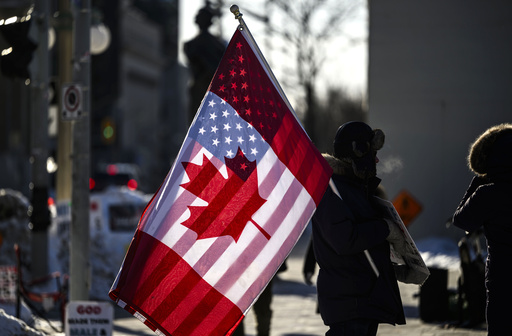
ATLANTA — President Donald Trump has initiated new tariffs on imports from Canada, China, and Mexico through executive action. This decision is in line with his campaign commitments but has triggered countermeasures that may lead to a prolonged trade conflict with key economic partners, particularly Canada and Mexico, who are also the United States’ closest neighbors.
During his 2024 campaign, Trump portrayed his economic strategy as an effective way to decrease living costs for Americans. However, he is now acknowledging the warnings of many economists that these tariffs could result in increased prices and diminished supplies in the market. This article provides key insights into Trump’s executive actions, the responses from trading partners, and the implications for consumers in the U.S.
The tariffs will impact the three largest trading partners of the United States. Trump declared an economic emergency allowing for a 10% tariff on all imports from China, and a 25% tariff on imports from Mexico and Canada, including energy products such as oil, natural gas, and electricity. These tariffs are set to be implemented on Tuesday and will affect a broad spectrum of goods within the U.S. market, including Canadian oil and lumber, Mexican produce and textiles, and Chinese computer chips, among others. Notably, Trump’s order does not include provisions for exemptions for U.S. importers.
The implications of this move are significant; Canada currently supplies over 4.3 million barrels of oil daily to the U.S., which consumes about 20 million barrels a day, while domestic production averages around 13.2 million barrels daily. The President has framed these tariffs not just in economic terms, but as measures against illegal immigration and drug trafficking. He claims that Mexico and Canada have not done enough to curtail the flow of fentanyl into American markets and that they contribute to a rise in migrant crossings at the southern border. “It is my duty as president to ensure the safety of all,” he stated.
In response to Trump’s actions, leaders from Mexico, Canada, and China have promptly reacted. Mexican President Claudia Sheinbaum announced immediate retaliatory tariffs. Canadian Prime Minister Justin Trudeau responded by declaring his intent to impose matching tariffs on nearly $155 billion worth of U.S. products. Trudeau has also urged Canadians to favor local goods, effectively promoting a boycott of American products. Furthermore, various provincial leaders in Canada have declared they will remove American alcoholic beverages from government-operated stores.
As of a recent update, China has not yet responded with tariffs of its own but has communicated that necessary countermeasures will be taken to protect its legitimate rights and interests. Additionally, China’s Ministry of Commerce announced intentions to pursue a lawsuit against the U.S. at the World Trade Organization due to what it deems wrongful practices by the U.S. government.
While consumers do not directly pay tariffs, the burden is likely to translate into higher prices at retail, as companies involved in the import process typically pass those costs downstream. Gregory Daco, a chief economist, estimates that the tariffs could raise inflation, which stood at 2.9% in December, by an additional four-tenths of a percentage point this year. Daco also projects a contraction in the economy, forecasting growth to decrease by 1.5% this year and by 2.1% by 2026. Estimates from Yale University indicate that the tariffs could collectively cost the average American household between $1,000 to $1,200 per year in purchasing power.
Moreover, the repercussions of the tariffs extend even to products marketed as “made in the U.S.A.,” since this label can sometimes signify mere assembly or finishing in the U.S. while utilizing foreign raw materials or parts. Consequently, rising energy costs, which are exacerbated by the tariffs and affect transportation expenses, may also lead to increased consumer prices. Given that Canada is a significant source of energy for the U.S., gas prices could rise, particularly in the Midwest where a large portion of Canadian crude oil is refined.
Interestingly, Trump has altered his tone regarding the potential consequences of these tariffs for consumers compared to his earlier exuberant promises during his candidacy. For instance, he had assured that grocery prices would drop “immediately” and that utility bills would be halved within a year of taking office. He often criticized the Biden administration for inflation and solicited support from those feeling the strain of rising living costs. In a recent interview, Vice President JD Vance maintains that the tariffs would translate into “more take-home pay” for American workers, yet Trump seems to be tempering such assertions.
“Will there be some pain? Yes, maybe (and maybe not),” Trump posted on social media, emphasizing that ultimately restoring American greatness would be worth any economic sacrifices made.

